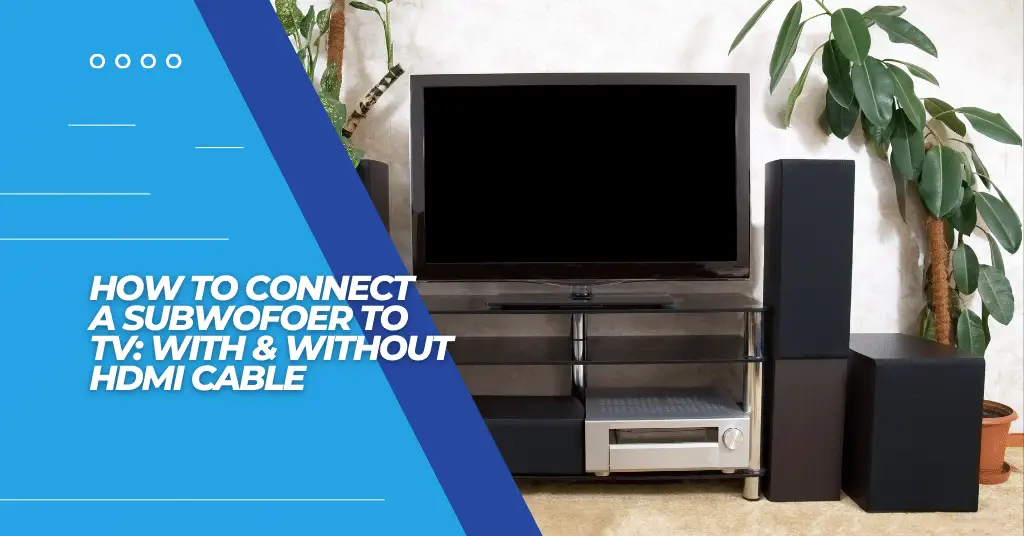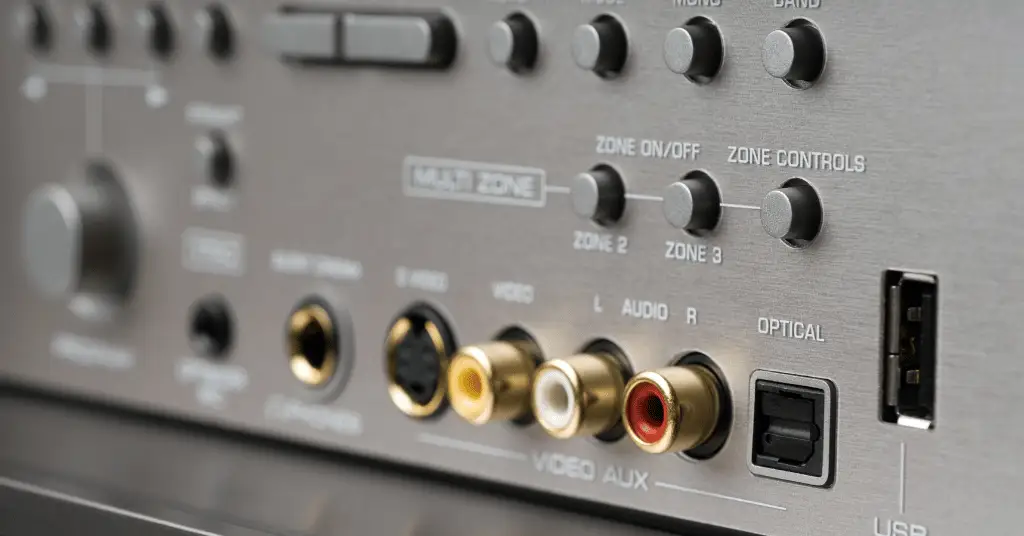How to Connect a Subwoofer to TV?

A subwoofer can add depth to your home entertainment or car audio system by adding depth to the movies or music. However, people frequently ask me about making the connection between the subwoofer and TV.
You can connect a subwoofer to a TV by identifying ports like HDMI ARC, RCA, or optical on both devices. If you have an HDMI port, just connect an HDMI cable between the TV and the subwoofer. Moreover, you can also use RCA or digital optical cables for respective ports.
That’s not all. I will discuss more recommended options below!
Connecting a Subwoofer to TV Using an HDMI Cable:

You can follow the below steps if you want to connect your subwoofer to a TV using an HDMI connection:
1. Ensure Compatibility:
Before proceeding to connection, I suggest you ensure you have HDMI ARC (Audio Return Channel) ports on both devices. These ports, usually labeled “ARC” on the device, are specifically designed to facilitate the transfer of both audio and video signals through a single cable.
2. Select a Quality HDMI Cable:
Don’t fall for the cheap components. Make sure you are using a high-quality HDMI wire for the best audio experience (eliminating any electrical interference). Believe me, it will ensure seamless audio transmission between your TV and subwoofer.
3. Make the Direct Connection:
Now that you have the quality cable, it’s time to connect your TV to the subwoofer. Before starting, please make sure both devices are powered off to prevent any misfortune.
Now, simply locate the HDMI ARC port on your TV; it is usually marked “ARC” for easy identification (which I have mentioned in the first step).
Insert one end of your HDMI cable into this port. Now, locate the HDMI ARC port on your subwoofer and plug in the other end of the cable.
This creates a direct, high-quality signal path between your TV and subwoofer, enabling better sound quality and more straightforward control options.
4. Power Up & Configure Settings:
Turn on both devices after connecting your TV and subwoofer using the HDMI ARC cable. Using your TV remote, navigate to the ‘Settings’ menu and look for ‘Audio Settings’ or a similar option.
In this menu, you should be able to find a setting related to ‘Speaker Setup’, ‘External Audio’, or ‘Sound Output’. Select ‘HDMI ARC’ (Audio Return Channel) as your preferred audio output here.
This setting allows the TV to send the audio signal to the subwoofer through the HDMI ARC cable, enabling your subwoofer to play the TV’s audio.
How to Connect a Subwoofer to a TV Without HDMI Cable?
If you want to connect your TV to the subwoofer without using an HDMI connection, you can use my following alternative options:

Follow the below steps if you want to use an A/V receiver to connect your powered subwoofer to a TV:
1. Check Compatibility:
The first step is to ensure your receiver has a dedicated subwoofer output, often labeled as “SUB OUT” or “SUBWOOFER OUT.”
This output will allow the subwoofer’s low-frequency signals to be appropriately directed. Then, observe your TV’s audio outputs and ensure they match an available input on your A/V receiver.
This could be HDMI, optical, or analog RCA. Lastly, ensure your active subwoofer has a corresponding input to the A/V receiver’s subwoofer output.
2. Connect the Subwoofer to the A/V Receiver:
Now, the A/V receiver is working as a middleman between your subwoofer and TV. First, you will have to connect the subwoofer to the A/V receiver.
Get a subwoofer cable (which is typically an RCA cable) and connect one end of the RCA cable to the port labeled “SUB OUT” or “SUBWOOFER OUT” on your A/V receiver.
Next, link the other end of the RCA cable to the “INPUT” or “LFE” port on your powered subwoofer.
3. Connect the A/V Receiver to the TV:
To connect your A/V receiver to your TV:
- Identify the “HDMI OUT” port on your receiver and an “HDMI IN” port on your TV (TV’s audio output jacks).
- Connect these ports using an HDMI cable, ensuring a high-quality video and audio signal transfer.
- If both your devices support HDMI ARC (Audio Return Channel), use these ports for a streamlined audio connection, allowing both incoming and outgoing signals via a single HDMI connection.
Alternatively, if HDMI is not an option on your TV, you can use an RCA cables for audio and video transmission between the TV and receiver. Connect the RCA cable to the corresponding colored ports on your TV and the receiver.
4. Configure A/V Receiver Settings:
Now, turn on your A/V receiver and your TV. You can configure the settings on your A/V receiver by navigating through the menu to locate the speaker or audio settings.
Look for the subwoofer setting in these settings and ensure it is enabled or set to “On.” The crossover frequency and volume settings are also located in this area, and you can adjust these based on your personal preference.
This will ensure you get the best audio experience from your A/V receiver.
Other Alternative Options:
1. Connection Through a Converter:
You can also use a port converter to connect the subwoofer and TV. The process involves a few simple steps:
- Begin by assembling the required components, which include a digital coax cable, an HDMI cable, and a converter with digital coax input and HDMI output.
- Now, locate the ‘digital coax output’ on your TV; it is usually marked and easy to find. Take one end of your digital coax input cable and connect it to this output. The other end should be connected to your converter’s ‘digital coax input’.
- Finally, take your HDMI cable and connect one end to the ‘HDMI output’ of your converter. The other end should be connected to the ‘HDMI input’ of your subwoofer. This completes the connection, and your subwoofer should now receive audio signals from your TV.
2. Using Bluetooth Adapter (For Smart TV):
You can also use an external Bluetooth adapter for the connection purpose between your TV and subwoofer. Therefore, get a Bluetooth adapter that is compatible with your subwoofer.
This adapter will function as the transmitter, sending the audio from your TV to the subwoofer. What you need to do is simply plug the adapter into your subwoofer’s audio input.
After setting up the adapter, power both your TV and the subwoofer. Activate the pairing mode on your Bluetooth adapter.
The method may vary depending on the model of your adapter, but it usually involves pressing and holding a pairing button.
The next step is done on your Smart TV. Navigate through the TV’s settings until you find the ‘Bluetooth’ or ‘Audio Devices’ option.
Select this option, and your TV will start searching for nearby Bluetooth devices. When your TV detects the Bluetooth adapter, it will display its name in a list of available devices.
Find the adapter’s name and select it. Confirm the pairing request that follows. And there you have it, buddy!
General FAQs
Is It Possible to Connect a Car Subwoofer to a TV?
Yes, you can connect a car subwoofer to a TV. The process requires an amplifier that matches the subwoofer’s impedance and power requirements and RCA-to-3.5mm or RCA-to-RCA cables, depending on your TV’s audio output.
Can You Connect a Subwoofer to a Laptop?
Yes, you can connect a subwoofer to a laptop. A 3.5mm RCA cable is required to connect the subwoofer to the laptop’s headphone audio output jack. Additionally, the subwoofer must have an internal amplifier since a laptop cannot drive it directly.
Can You Use a Car Subwoofer for a Home Theater System?
Yes, you can use a car subwoofer for a home theater system. However, it requires specific wiring and power considerations. Car subwoofers are designed for 12V DC operation, unlike home audio systems operating on 110-120V AC. So, you will need a suitable power supply or converter to make it compatible with your home theater system.
What’s the Difference Between an HDMI ARC and a Regular HDMI Port?
An HDMI ARC (Audio Return Channel) audio input port is a feature in the HDMI protocol that enables the receiving and sending audio signals directly from your TV to your sound system, negating the need for extra audio cables. A regular HDMI port, while capable of transmitting both video and audio signals, does not support this beneficial two-way communication.
Can I Connect Multiple Subwoofers to My TV?
Yes, you can connect multiple subwoofers to your TV. However, you’ll need an AV receiver with multiple SUB outputs to do this correctly. The receiver will distribute the audio signal to each subwoofer, creating a balanced sound.

Hello Mike,
Well, I read a ton of reviews for the Samsung 990c wireless soundbar and purchased the system. Unlike others, I do not find the sub to be that great. Actually I want to add a sub. This bar only has one output HDMI, the eArc. No sub out, no aux. I also have a Samsung TV with the eArc, so both of them are taken. My TV has optical, coax and more HDMI slots. If I am understanding your article, I can add a sub to my TV via optical/HDMI? Will I then just use the pass through to the soundbar? Can the TV actually send signals to both optical, HDMI and eArc? I would love to figure this out. In addition I equally am not impressed with the rears. I would love to get powdered speakers for the rears. I know that is a lot, but I’m looking at over $600 to add these. I haven’t purchased the equipment as yet as that just wouldn’t be prudent. Help me Mike, Please !!!!!
Since your Samsung 990c soundbar lacks a dedicated subwoofer output and the user’s TV is already using its eARC HDMI slot for the soundbar, in my opinion, the best approach to add an external subwoofer is by using the TV’s available outputs. However, it can be challenging to add a subwoofer directly to the TV due to signal processing and compatibility issues, especially if your TV doesn’t support low-frequency effects (LFE) output through optical or HDMI ports.
There, a more viable option can be to look for an active subwoofer with high-level inputs. Unfortunately, since your TV and soundbar setup might not be easily accommodate this, another workaround isn’t straightforward without additional equipment.
I would suggest you use an HDMI Audio Extractor. A good HDMI audio extractor has the ability to split the audio signal from the video, allowing you to connect it to different audio devices. You can connect this extractor in between your TV and the soundbar. The extractor would take the HDMI input from the TV and provide an HDMI output to the soundbar, plus you can get additional audio outputs like optical or coaxial that you could potentially use to connect to an external subwoofer. However, you have to be careful with the compatibility of the soundbar and subwoofer, particularly for managing audio sync and ensuring the audio extractor passes through 4K or HDR content correctly if needed.
For your question: Can the TV actually send signals to both optical, HDMI and eArc?
Yes, some TVs can send audio signals to multiple outputs simultaneously, such as optical, HDMI, and eARC. However, the ability to do this and how it’s managed can vary depending on your TV’s make and model. In some TVs, users are allowed to select multiple audio output options in their sound settings, while others might automatically disable one output when another is active. Therefore, you should read the user manual or settings of the specific TV model to understand how it handles multiple audio outputs.